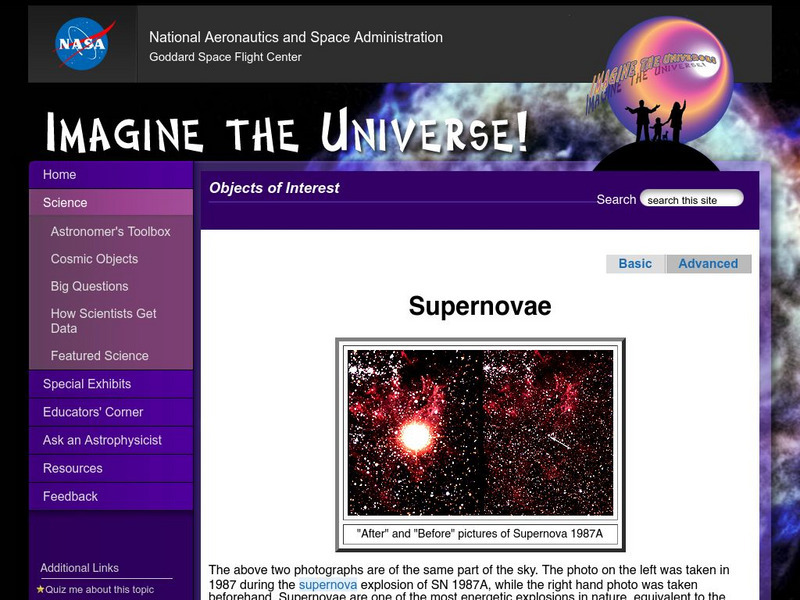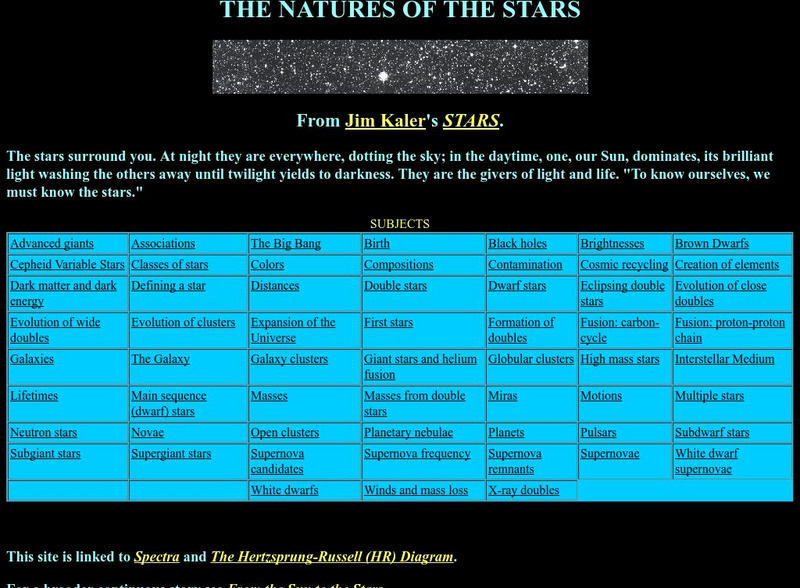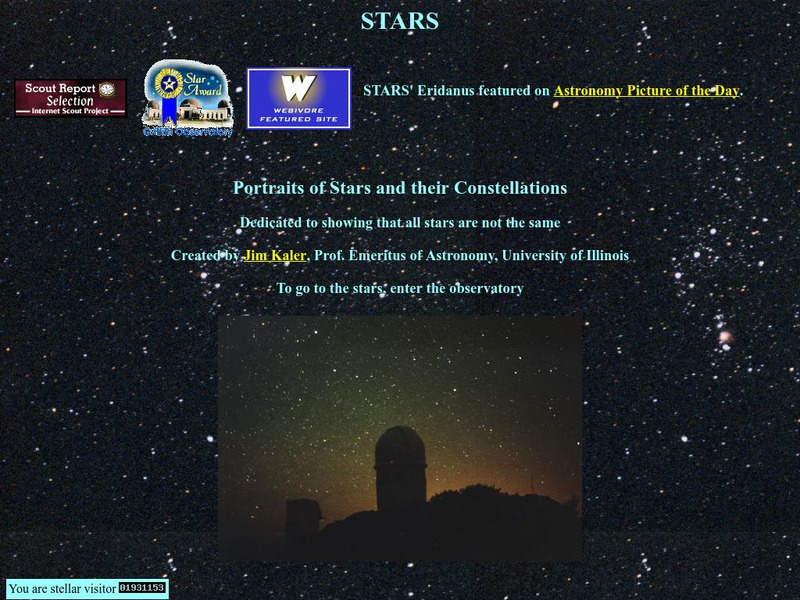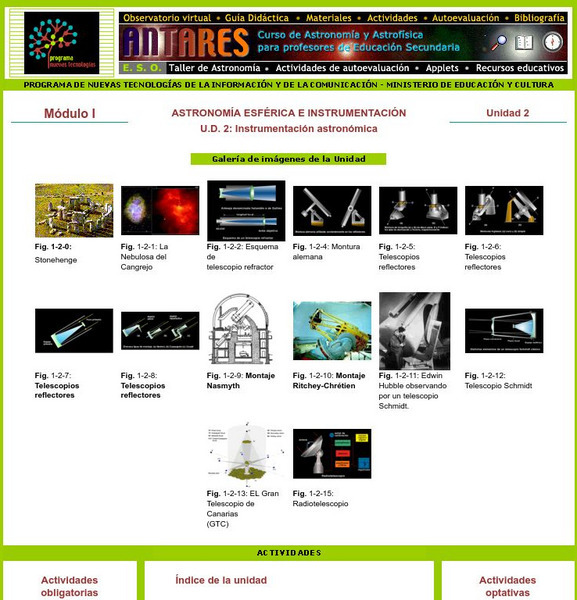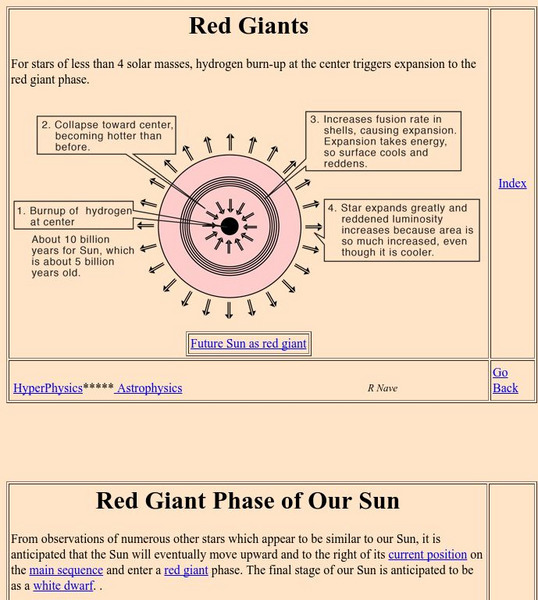NASA
Nasa: Imagine the Universe: Supernovae (Advanced)
Supernovae are divided into two basic physical types, including a description of supernova types and how they are classified based on the existence of hydrogen spectral lines. Definitions of key terms are provided.
NASA
Nasa: Mars and Earth: Science Learning Activities for Afterschool
This set of activities teaches students about the big picture of science using Mars as an example: how to collect data, use evidence, and look at models.
NASA
Nasa Star Child: Quasars (Level 2) Information
NASA presents the amount of energy, type of energy, brightness, and the detection of quasars. Provides several examples, pictures, and information.
NASA
Nasa: Goddard Scientific Visualization Studio
This impressive exhibit of images and videos is available to see how NASA uses technology to track the weather. You can search by keyword for more specific images.
California Institute of Technology
Welcome to Cool Cosmos!
Site provides a cosmic classroom, an image gallery, science resources, fun and games, and much more!
Wikimedia
Wikipedia: The Black Hole
This site examines the black hole as an object in astrophysics. Delve into this comprehensive resource that covers this concept from its history, to qualitative physics, the reality of black holes, mathematical physics and more.
California Institute of Technology
Ipac: Iras Gallery
This site from IPAC is a series of images of various celestial objects and regions as viewed in infrared light. Each photo is accompanied by a caption.
PBS
Pbs Teachers: Scientific American: Science in Paradise: Big Dish
Investigate the science of radio astronomy, and create a model of a curved reflecting dish that will work like the Arecibo detector to detect electromagnetic waves. Explore risk using a risk space grid.
Curated OER
Science Kids: Science Images: Satellite Dish
A photo of two huge satellite dishes aimed into space that are used for research in the field of space and astronomy.
E-learning for Kids
E Learning for Kids: Science: Madagascar: What Is the Solar System?
Patrick loves being a pirate, but he'd prefer to be an astronomer. Join him, and learn about everything high in the sky like the moon, stars, and asteroids.
University of Illinois
University of Illinois: Stars and Constellations: Neutron Stars and Pulsars
This resource provides a brief description of the relationship between a neutron star and a pulsar. It details the pulsing rate and death of a pulsar.
University of Illinois
University of Illinois: Stars and Constellations
A large collection of information about and photos of the starts and constellations in the sky.
Ministerio de Educación (Spain)
Ministerio De Educacion: Instrumentacion Astronomica Modulo I Unidad 2
In this unit you will combine all the major components of a telescope to obtain the desired system for different types of astronomical observations.
Ministerio de Educación (Spain)
Ministerio De Educacion: Instrumentos Auxiliaries Modulo I Unidad 3
In this unit you will learn the main advantages and disadvantages offered by the refractor and reflector telescopes for a particular observation. You will also learn about the main types of telescopes.
Ministerio de Educación (Spain)
Ministerio De Educacion: Espectros Estelares Modulo Ii Unidad 2
In this module you will study the composition of stars. You also will be able to classify them through the virtual observatory.
Virginia Tech
Virginia Tech: Frequently Asked Questions About Quasars
This site from Virginia Tech provides answers to a list of questions about quasars.
University of California
University of California Berkeley: Black Holes Faq
A detailed list of questions and answers concerning black holes that defines black holes and describes their basic physics and characteristics.
NASA
Nasa: Imagine the Universe: White Dwarfs
Brief description of white dwarfs with respect to their position in the life cycle of stars, the density of white dwarfs, the emissions of white dwarfs, and the temperatures associated with them.
Georgia State University
Georgia State University: Hyper Physics: Red Giants
Describes the red giant star's development stages and the scenario of our sun as a red giant. Diagrams are used to present the information.
NASA
Nasa: Wmap: Fate of the Universe
A general look at the expansion of the universe and the Big Bang theory.
Enchanted Learning
Enchanted Learning: Crafts for Kids
Choose from dozens of simple crafts including activities for the holidays, animal crafts and much more.
Harvard University
Field Guide to X Ray Sources: Brown Dwarfs
Brown Dwarfs are explained. Includes illustrations.
Harvard University
Quasars and Active Galaxies
This site provides information about quasars and active galaxies. Includes a glossary of important terms.
Harvard University
Chandra X Ray Observatory Center: X Ray Pulsar
X-ray pulsars are explained. Features a Java applet that simulates a pulsar and allows the viewer to control the rotational speed.
Other popular searches
- Astronomy and Space Science
- Space Science Astronomy
- Space and Astronomy
- Preschool Astronomy/space
- "Astronomy and Space Science
- Astronomy and Space Lesson
